Address any questions or comments regarding this newsletter to the individual authors listed after each article or to its editors, Nathan Johanning, 618-939-3434, njohann@illinois.edu or Bronwyn Aly 618-695-6060, baly@illinois.edu. The Illinois Fruit and Vegetable News is available on the web at: http://ipm.illinois.edu/ifvn/. To receive or be removed from email notification of new postings of this newsletter, contact Nathan Johanning or Bronwyn Aly at the phone numbers or email addresses above.
In This Issue:
Upcoming Programs (listings for beginning and established growers)
News & Announcements (Produce Safety Alliance Grower Trainings (x2), Launch of the Produce Safety Technical Assistance Network (TAN))
Regional Reports (St. Louis Metro East, southern Illinois, Dixon Springs)
Fruit and Vegetable Pest Management (Post-Harvest Handling of Pumpkins, Summer Cover Crop Growth and Termination)
Upcoming Programs
See the University of Illinois Extension Local Food Systems and Small Farms Team’s website at:
http://web.extension.illinois.edu/smallfarm/ and the calendar of events at http://web.extension.illinois.edu/units/calendar.cfm?UnitID=629.
- Boone County Farm Stroll, Sunday, October 6, 2019 from 12 p.m.-5 p.m. Free self-paced tours of diversified family farms. https://web.extension.illinois.edu/units/event.cfm?EventID=81622&UnitID=463
- Twilight Field Day at Huyck Farms, Tuesday October 29, 2019, 5 p.m. 3005 Cairo Road Paducah, KY 42001. This program will cover the basics of cole crop production and a tour of a colored cauliflower variety demonstration trial. For more information contact Kathryn Wimberley at the McCracken Co. Extension Service at 270-554-9520.
- 2020 Illinois Specialty Crops Conference, January 8-10, 2020, Springfield, IL. Save the date!!!! https://www.specialtygrowers.org/2020-save-the-date . More information to follow later in the year but mark your calendars now and plan on attending the pre-conference workshops, conference programming, trade show, and annual association meetings!
- 2020 Southern Illinois Fruit and Vegetable School, Wednesday, February 5, 2020, Mt Vernon Doubletree Inn. This program includes separate tracks for small fruit, tree fruit and vegetable production. Save the date and more information to follow!
- 2020 Southwest Illinois Commercial Tree Fruit School, Tuesday, February 4, 2020 at the Knights of Columbus Hall just south of Hardin, IL. Save the date and more information to follow!
- Introduction to Produce Safety
- Worker Health, Hygiene, and Training
- Soil Amendments
- Wildlife, Domesticated Animals, and Land Use
- Agricultural Water (Part I: Production Water; Part II: Postharvest Water)
- Postharvest Handling and Sanitation
- How to Develop a Farm Food Safety Plan
News & Announcements
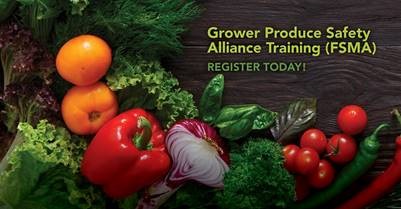
The FOOD SAFETY MODERNIZATION ACT (FSMA): PRODUCE RULE impacts almost all fruit and vegetable growers. If you grow, harvest, pack, or hold produce, you may be subject to part or all of the Produce Rule. Even if the rule does not apply to you, you are encouraged to take the class.
In addition to learning about produce safety best practices, key parts of the FSMA Produce Safety Rule requirements are outlined within each module. There will be time for questions and discussion, so come prepared to share your experiences and produce safety questions.
When: Monday, October 7, 2019 from 8am to 5 pm
Where: Donald E. Stephens Convention Center in Rosement, Illinois (a northwest suburb of Chicago)
Cost: Free, but pre-registration is required at http://www.ilfb.org/FSMA
The class, manual, and certification are free and includes lunch.
Class trainers Zachary Grant – University of IL Extension, Cook County and Don Stoeckel, PhD. - Produce Safety Extension Associate, will spend approximately seven hours of instruction time covering content contained in these seven modules:
This pre-conference workshop is hosted by Illinois Farm Bureau in conjunction with the 2019 National Direct Agricultural Marketing Summit.
For Questions about this program, please contact:
Raghela Scavuzzo
Illinois Farm Bureau
(309)557-2155
(309)532-9674
RScavuzzo@ilfb.org
Produce Safety Alliance - Grower Training Course
Do you have concerns about safety in your produce operation? Are you concerned about compliance with FSMA? Do you want to know more about the difference between FSMA and GAPs? Then the Produce Safety Alliance Grower Training might be for you!
On December 18, 2019, from 8:00am to 5:00pm CST, U of I Extension in conjunction with Southern Illinois University will be holding a Produce Safety Alliance Grower Training workshop at the SIU Agronomy Research Center, 3268 W. Pleasant Hill Road, Carbondale, Illinois.
The PSA Grower Training Course is one way to satisfy the FSMA Produce Safety Rule requirement outlined in § 112.22(c) that requires ‘At least one supervisor or responsible party for your farm must have successfully completed food safety training at least equivalent to that received under standardized curriculum recognized as adequate by the Food and Drug Administration.’
After attending the entire course, participants will be eligible to receive a certificate from the Association of Food and Drug Officials (AFDO) that verifies they have completed the training course. To receive an AFDO certificate, a participant must be present for the entire training and submit the appropriate paperwork to their trainer at the end of the course.
Costs to Attend
Registration, training materials and handouts, lunch, and Association of Food and Drug Officials (AFDO) certificate of completion will be covered through funds from the Illinois Farm Bureau. Certificates are required for individuals looking to meet the conditions of the FSMA Produce Rule.
Registration will close on December 3, 2019. There are a limited number of seats available for this training. Once the course is full, registrations will close.
Registration can be completed at:
https://extension.illinois.edu/events/2019-12-18-produce-safety-alliance-grower-training
Questions can be directed to Laurie George at ljgeorge@illinois.edu or Ruplal Choudhary choudhry@siu.edu
Launch of the Produce Safety Technical Assistance Network (TAN)
In November 2015, the Food and Drug Administration (FDA) released the Final Rule for Standards for the Growing, Harvesting, Packing, and Holding of Produce for Human Consumption, otherwise known as the Produce Safety Rule, required by the FDA Food Safety Modernization Act (FSMA). This rule establishes science-based standards for the production and harvesting of certain produce, including sprouts. In October 2018, the FDA published a draft compliance and implementation guidance to help covered farms comply with the requirements of the Produce Safety Rule. The draft guidance provides a broad range of recommendations on how to meet the requirements for most subparts of the rule. It also outlines how to determine whether produce or farms may be eligible for exemptions from certain requirements, or from the rule in its entirety.
Regulation and policy interpretation questions related to the Produce Safety Rule should continue to be submitted to the FDA FSMA Technical Assistance Network (TAN). In addition, the Food Safety Preventive Controls Alliance (FSPCA) has also developed their own Technical Assistance Network. In the past, the FSPCA TAN has supported inquiries related to the FSMA Preventive Controls Rules, the Foreign Supplier Verification Program (FSVP), sprout safety, and other FSMA programs and activities. The FSPCA TAN is also now open to receive technical questions related to Produce Safety Rule and related guidance. Questions can be submitted by visiting the produce section of the FSPCA TAN webpage. The inquiries submitted to the FSPCA TAN are referred to extension staff for a response.
Submit a Question to the Produce Safety TAN
Laurie George (618-548-1446; ljgeorge@illinois.edu)
Regional Reports
From the St. Louis Metro East…
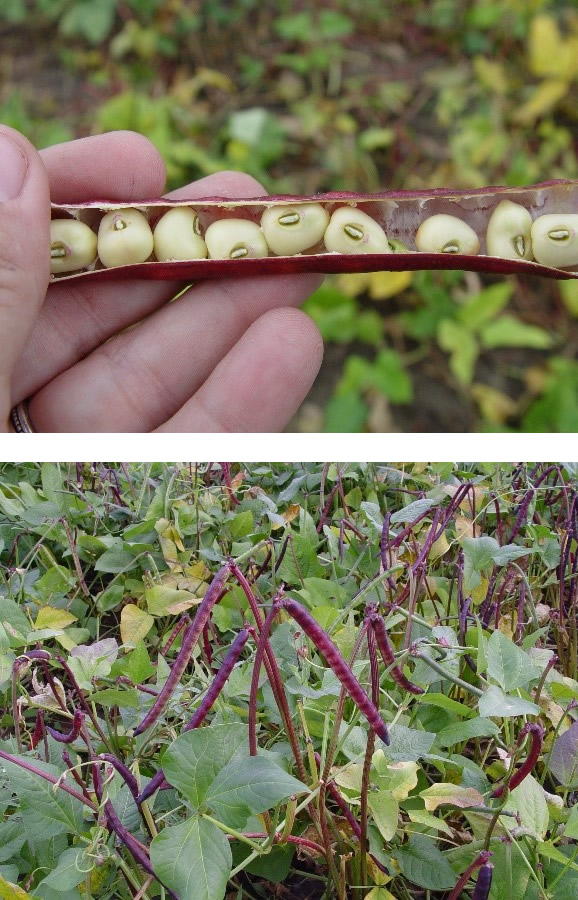
The pumpkin crop is looking great, despite very challenging powdery mildew conditions. It’s mid-September but you wouldn’t know it by the heat and humidity. Night temperatures are back in the 70’s with humidity in the low 90’s. Great for ripening pumpkins and watermelons, but less so for coloring red apples. The greens crop is suffering under this unusual heat, so a return to cool nighttime temperatures is much needed. In addition to the pumpkin season just opening up, watermelon and cantaloupe will be finishing up in the next week or so. Snap beans, crowder peas and lima beans are in their harvest window as well. Harvest of sweet potatoes will probably begin sometime next week. On the fruit side, peaches have finished and apple harvest has moved into the Golden Delicious window. Jonathans are almost done or finished in the region. Still picking Pixie Crunch. Color picking Red Delicious has started, with cultivars like Firm Gold and Fuji up next.
Elizabeth Wahle (618-344-4230; wahle@illinois.edu)
From west central Illinois… The weather tricked us a couple of times last week. It has been a roller coaster of temperatures swings, from 90+ degrees and schools being let out early due to heat, down to 58 degrees Fahrenheit, with everyone huddled around a fire this past weekend during a birthday bonfire. On September 7, we hit a low of 51 degrees. It is all a signal that, ready or not, fall is right around the corner.
As we transition to cool-season crops, the warm season ones are winding down. The tomatoes continue to yield quite a bit despite their haggard appearance. Splitting of fruit has been an issue this season with long periods of no rain interspersed with drenching storms.
The butternut squash has also done remarkably well, despite all the squash bugs. I have sprayed three times this season starting in August for squash bugs. The sprays have been timely on cloudy days when pollinators are not as active. With it being this late in season, I have decided to hold off on any more sprays to manage squash bugs. In fact, I have found mummified corpses of squash bugs, with a small opening in their abdomen suggesting they were parasitized. According to an article by Washington State University entomologist William Snyder on eOrganic, squash bugs do have some natural predators such as ground beetles and damsel bugs. A tachinid fly, Trichopoda pennipes, is a known parasitoid of squash bugs. The female fly lays her eggs on the underside of the large squash bug nymph or adult. From there the fly larva burrows into the bug and feed on the inside, eventually killing it. Snyder reports that control rates of squash bug by the tachinid fly can reach 100% (Pickett et al., 1996). Before you shelve the chemicals for the flies, most of this control is only seen late in the season, after squash bugs have wrought their damage. Snyder concludes that “…parasitoids may be most important in lessening the year-to-year buildup of squash bugs on a farm, rather than achieving pest control within any single year.” Link to eOrganic article https://eorganic.org/node/5313
The four-legged mammals (likely raccoons) have been a nuisance lately. However, some of the destruction of the plant material almost suggests vandalism of the two-legged mammal. Perhaps we need to beef up the fencing around the garden and post some signage to discourage vandals. My favorite sign to keep humans out read “Warning – Experimental pesticides in use. Highly toxic! DO NOT HARVEST” The farm that posted these signs even went so far as to sprinkle flour on some of the plants.
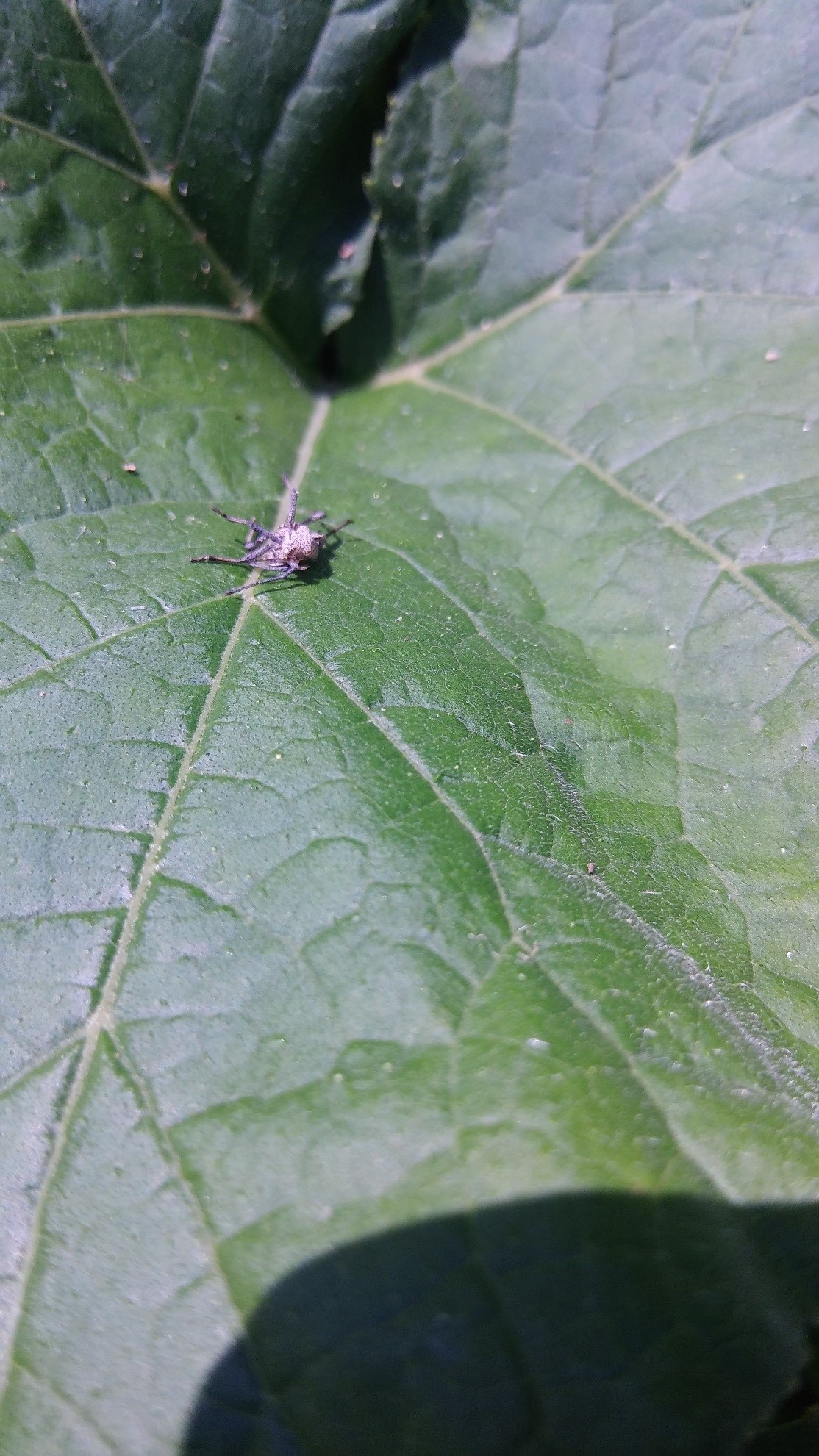
The remains of a parasitized squash bug. Photo: Chris Enroth
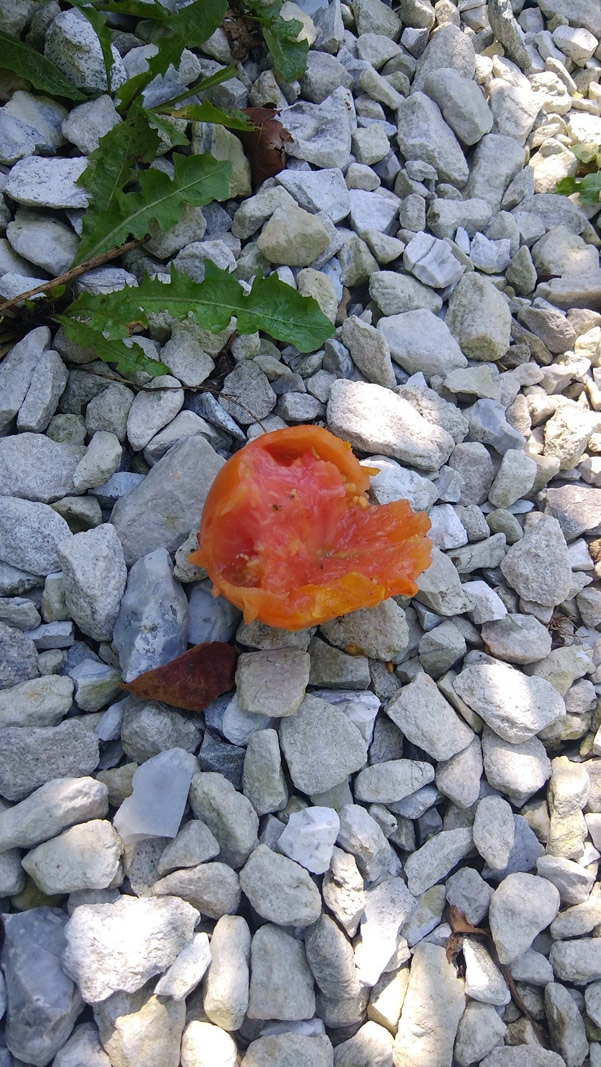
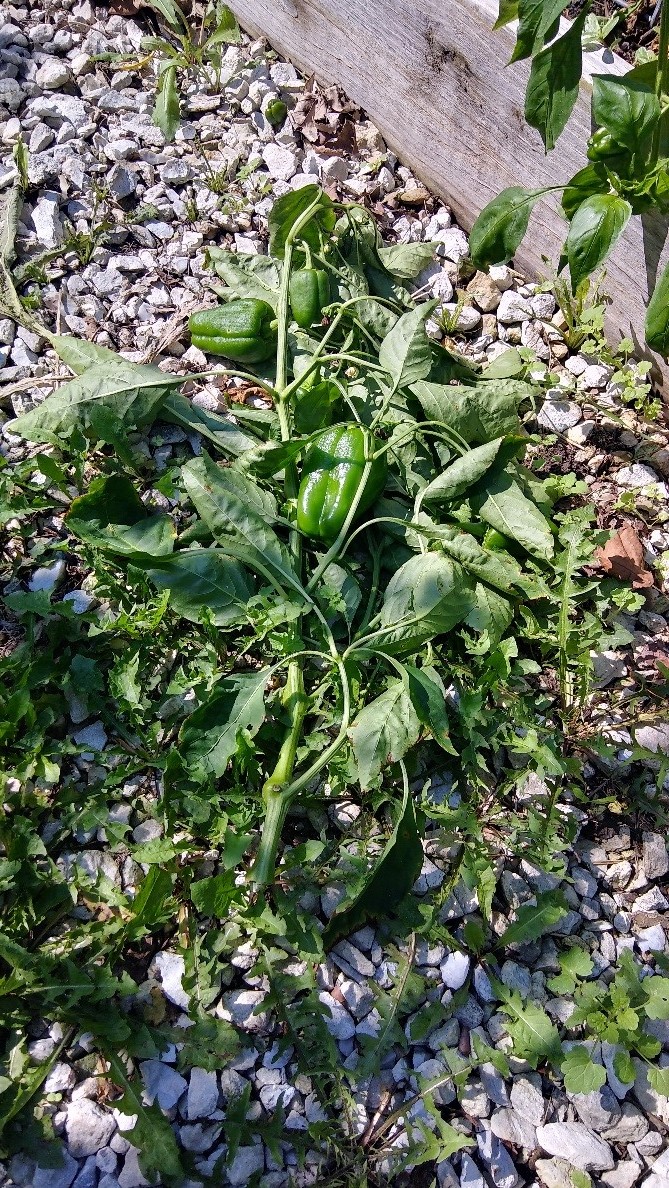
Half-eaten tomato and pepper plant torn to shreds. This is due to four-legged mammal pests, but always keep an eye out for signs of the two-legged mammals. Photos Chris Enroth
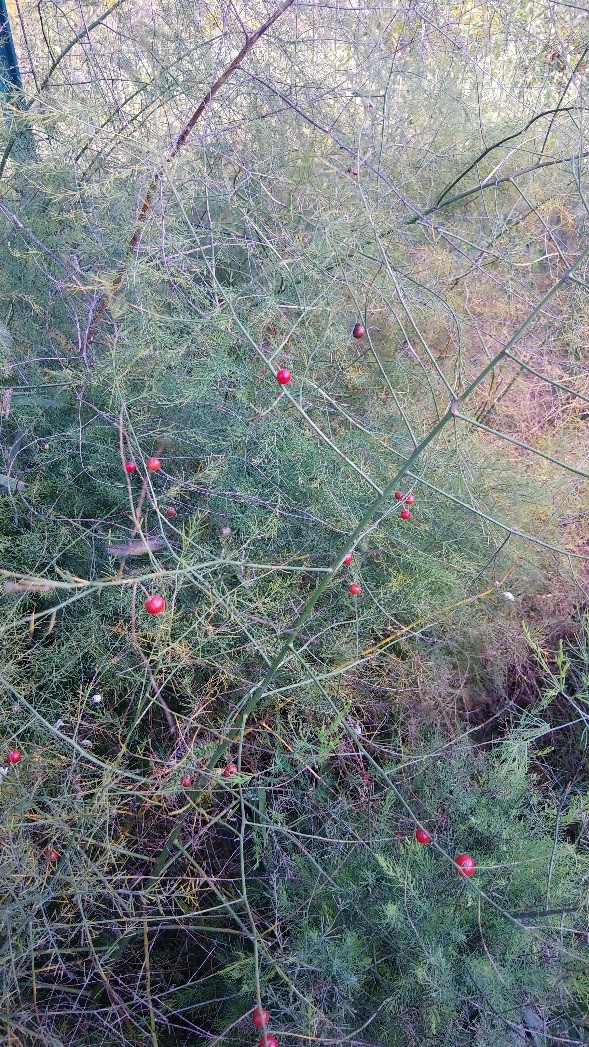
Of the twenty Jersey Knight asparagus crowns we planted, one turned out to be female. While these should be mostly male plants, it is inevitable to have a small percentage of female plants. The females develop red berry-like fruits and tend to have lower yields, which likely will not be noticeable for backyard or small-scale growers. Photo: Chris Enroth
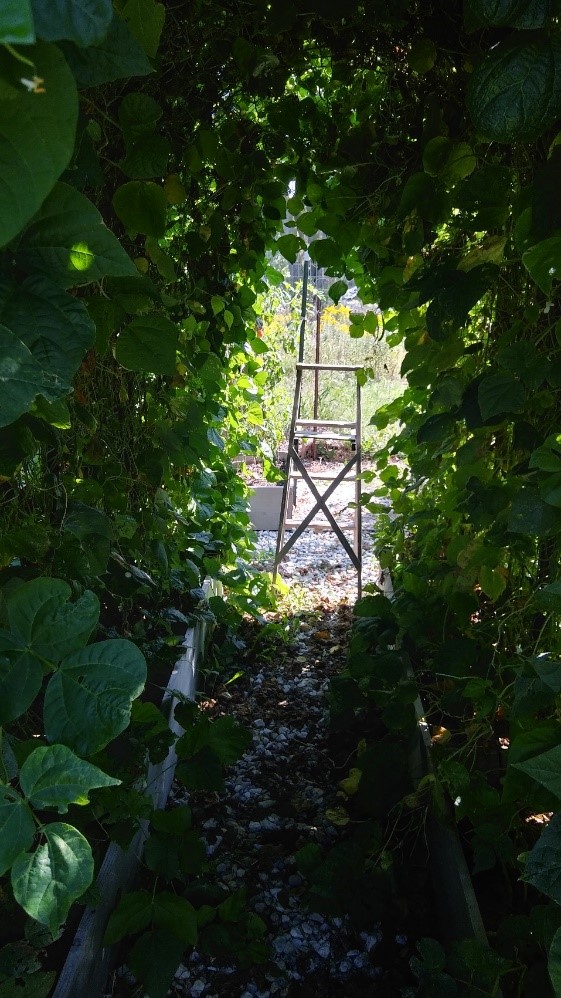
Bean Tunnel: I have never seen pole beans grow as vigorously as this year. They even out-paced the Japanese beetles. Walking under the canopy of bean vines puts one in instant darkness. Photo: Chris Enroth
Chris Enroth (309-837-3939; cenroth@illinois.edu)
From southern Illinois... Although fall on the calendar is here you can’t quite feel it most days lately. We have had mulitple days up in the 90s the past week. We have a breif break but the temperatures again are predicted to get up in the low 90s many days in the next few weeks. Friday (9/20) we did get 0.5” of rain, but that didn’t last long and didn’t go far as dry as it has been. There are some rain chances in the forecast but not too much.
So long as plants have a good root systems to find water, (or irrigation), the dry weather has been much welcomed for late vegetable crops. Diseases pressure has been lower for many of our pathogens that need moisture to thrive and we haven’t had to worry about harvesting in the mud! Compared with a year ago, I feel conditions are actually better for our crops. We haven’t had the cooler temperatures we would expect to help some fall, cool-season crop plantings.
The heat has really pushed pumpkin maturity and they are ripening very fast. Except for a few spots on hillsides, I haven’t seen much moisture stress even with the dry so the plants are still able to pull some moisture from deeper in the soil or from roots off of the vine. Below I have a picture of the first harvest on half of one of my blocks of Jack O’Lantern Pumpkins on my own farm. I have been happy with the growth and fruit quality. These are all ‘Eagle City Gold’ which is a new vareity for me from Rupp’s. We evaluated it last year at out pumpkin trials at the Ewing Demonstration Center and it performed well there. They have a well attached, dark green stem with a very nice shape and dark orange color. There are still many green and partially green fruit in this block that will be ready to harvest soon.
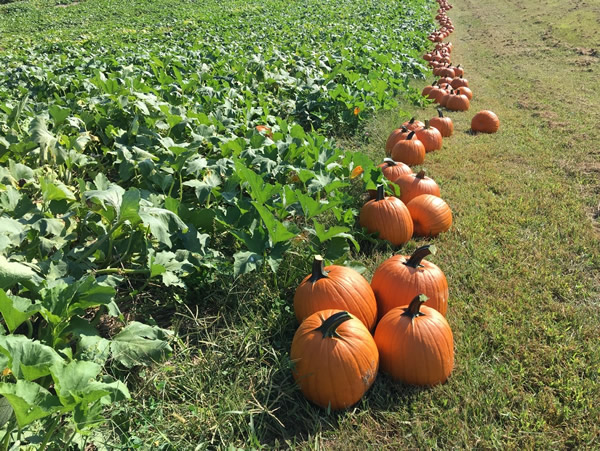
First harvest on a block of ‘Eagle City Gold’ pumpkins. Photo: N. Johanning.
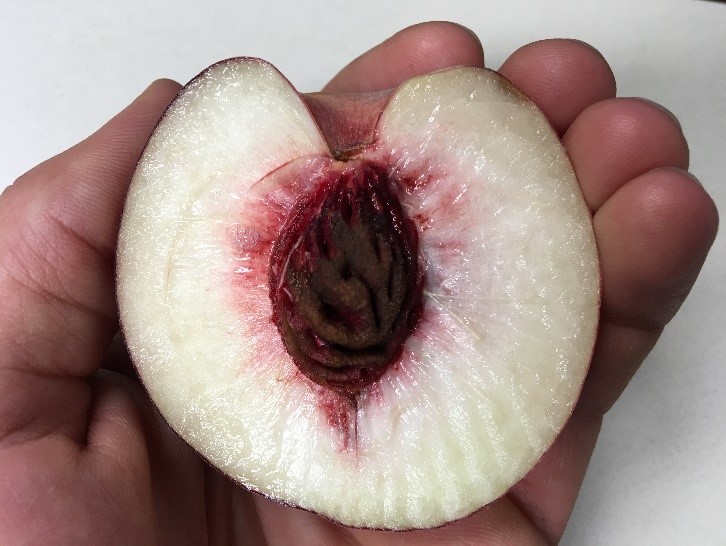
Late peach variety September Snow. Photo: N. Johanning.
Out in the orchard apple harvest continues with some of the later varieties. There are still a few growers that have some late peach varieties. On that I ran across was ‘September Snow’ which is a white, low acid peach that is more firm, but has nice size. I have been enjoying some and the are very sweet, but some are more firm and crisp more comparative to an apple. Vareities like this can be great for a farm market that want to have a niche for a late peach market.
Nathan Johanning (618-939-3434; njohann@illinois.edu)
From Dixon Springs Ag Center…
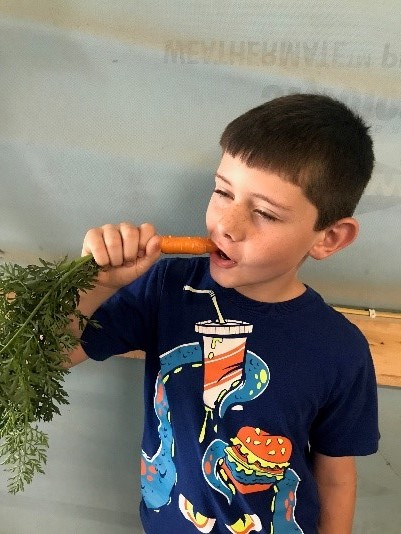
My two-legged wascally wabbit was the first to sample a carrot that was pulled from the August 8th planting in the high tunnel. We were not expecting to see a carrot quite this size already but I guess we need to start preparing for our first harvest soon.
Harvest of cucumbers, tomatoes, peppers, and cut flowers is still continuing weekly in both the hydroponic and raised ground bed tunnels. We have been experiencing extremely hot days and are very much in need of rain. The occasional cool front has blown through, making you think the fall cool down is beginning, but then the temperatures jump back up into the high 80’s to low 90’s, and you are reminded that summer is really hanging on this year.
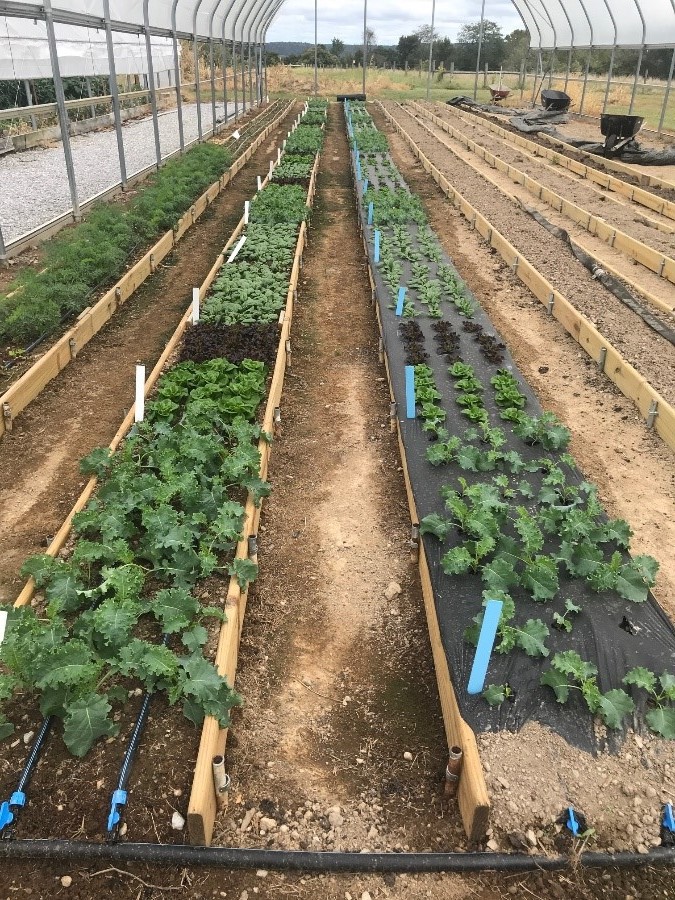
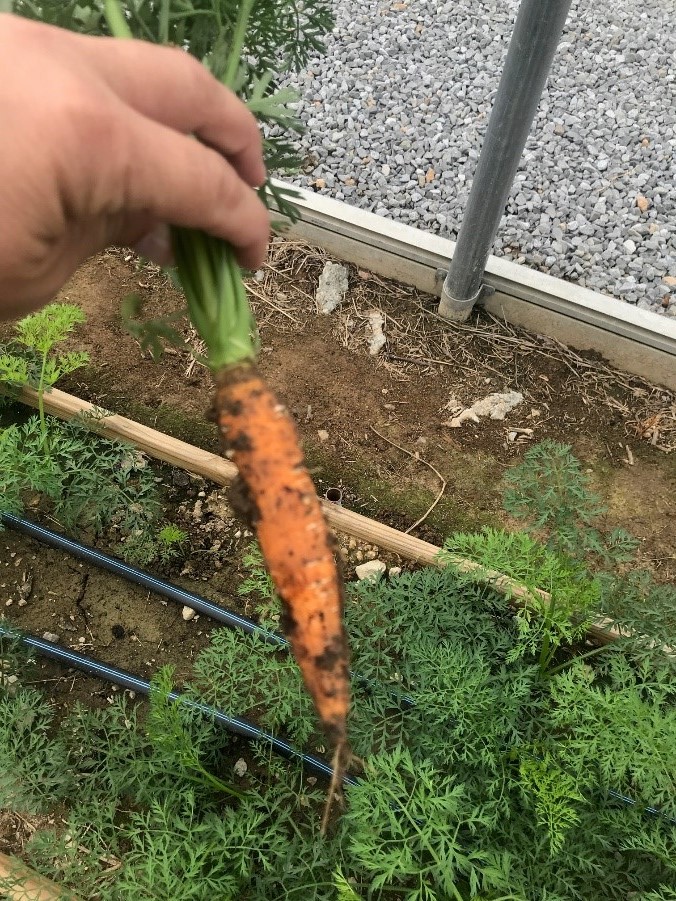
The picture above left shows a great side by side comparison of one of the treatments incorporated into our winter vegetable high tunnel project. Along with plant date and row covers (once we reach freezing nighttime temperatures), the use of black plastic mulch in lettuce, kale, and spinach plantings is also being evaluated. The two rows in the photo above were planted on September 6, 2019. The row on the left with no plastic has grown much better in the short amount of time compared to the row on the right that appears to be suffering from the added heat created from the black plastic. The next two plant dates may tell a different story. The picture on the right is of the carrot pulled from one of the August 8, 2019 plant date plots. It was about 6”-6.5” in length and about an inch in diameter. From the brief sample I got before my son ate the rest, it appeared to be relatively tender with mild sweetness, although I did note some bitterness as well. Harvest will begin very soon on August planted carrots and early September planted lettuce, kale and spinach. We are using double rows of drip tape with emitter spacing of 4 inches, and this appears to be delivering a very uniform pattern of watering to all of the plots.
Bronwyn Aly (618-382-2662; baly@illinois.edu)
Bronwyn Aly (618-382-2662; baly@illinois.edu)
Fruit and Vegetable Pest Management
Post-Harvest Handling of Pumpkins
Here are a few thoughts to consider about handling pumpkins post-harvest and how you set up market/farm stand displays.
-Keep them dry. After harvest keeping water off of fruit will lessen the chances of any progression of bacterial spot (if present) or reduce the opportunity for an secondary infections that could cause fruit rot.
-Keep them out of the direct sun. Pumpkins can sunburn easily if they are left out in the sun for multiple days especially on days with high temperatures. At a farm market this can be hard to avoid but certainly pumpkins that need to be stored for later sales are better kept out of direct sun. Although I don’t have an index of this, I feel that certain varieties are more prone to sunburn than other. Also many of the “whites” will tend to fade to a cream color in the sun. Overall, BOTH sun and rain can fade fruit color and leave them not as bright and eye catching to the consumer, as they were at harvest. If your market does have fruit out in the sun, consider holding some back in a shed/shade and then replenish the sales area, especially for the first few weeks with the hot temperatures and sun predicted.
-Keep them out of the mud. Keep them in bins, pallets or not directly in touch with the ground. If you do display fruit out on the ground, having a decent sod or straw can be a good compromise. The goals is to keep them 1) clean and 2) from any soil pathogens that could cause rot.
-Plant & Disease management. A pumpkin that comes off a healthy green vine, will keep far longer than one from a dead dying vine. Keeping good nutrient supply to plants and preventing diseases can go a long way to determine the storage of the fruit. Powdery mildew can be especially problematic on the stems, causing them to shrink up after harvest.
Now I know some of these are hard to all accomplish in many of our on-farm fall market displays, but things to consider especially if you have had issues with fruits keeping after harvest in the past. In my experience, a bright colored, healthy fruit is good for marketing and over time can build your base of satisfied repeat customers!
Nathan Johanning (618-939-3434; njohann@illinois.edu)
Summer Cover Crop Growth and Termination
Now is the time to think about seeding some cover crops as you have fields that open up and are done for the season, but it is also good to check on any summer cover crops you have planted and check if they need to be terminated to prevent seed production. I have shared a lot about some of our experience with some summer covers especially cowpeas and below I have a few pictures and observations. These are some cowpeas planted mid-June in a fallow area (so about 3 months of growth). They were broadcast at 100 lbs/A on tilled soil and harrowed in. The stand was good and we had excellent weed suppression. This area has a lot of weed pressure from foxtail, crabgrass, pigweed and also hophornbeam copperleaf. I would say we suppressed over 98% of the pigweed and copperleaf and 95% of the grasses. If you look in the picture below you can find a few stray crabgrass seed heads, but virtually no broadleaves. The cowpeas grew upright until they lodged and fell over. It kind of makes a jungle of sorts but excellent cover and weed suppression. If you pull out a plant you can see they are over 6 ft long. Also as a legume they produce nitrogen and their roots help to loosen the soil for next season.
They do winter kill, but you do want to be aware of seed production as they can re-seed themselves. As you can see these plant are just starting to set some immature pods and I, personally don’t want to have seed production so I opted to terminate them now versus waiting for frost. I simply mowed them down a tractor and good bush hog type mower. There is a lot of biomas to mow, but they are not hard to mow. You will get very little if any regrowth after mowing. The residue that is left will break down quickly as it has a low carbon to nitrogen ratio, so it won’t be hard to work in or manage in the spring. However, there is a enough residue that is will continue to suppress any winter annual weed germination limiting the green material you have to deal with early next spring. This is a great option for anything you need to till early in the spring next year, in my case potatoes.
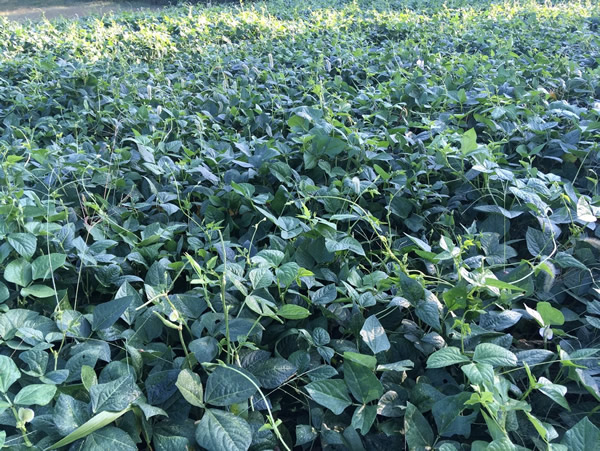
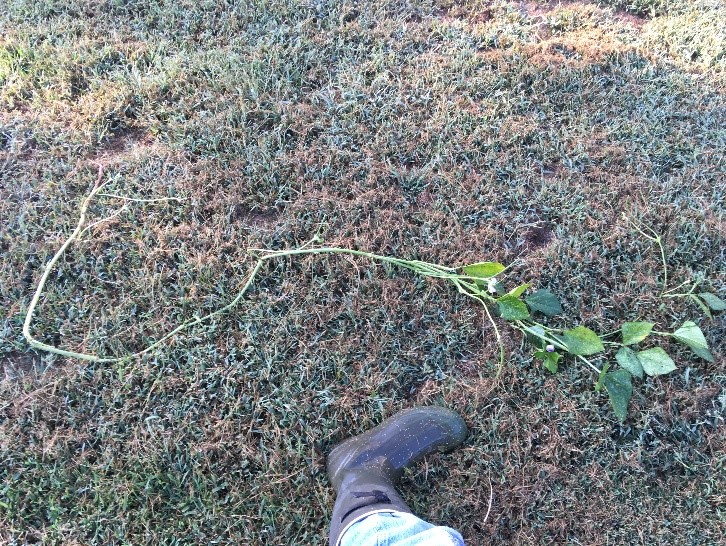
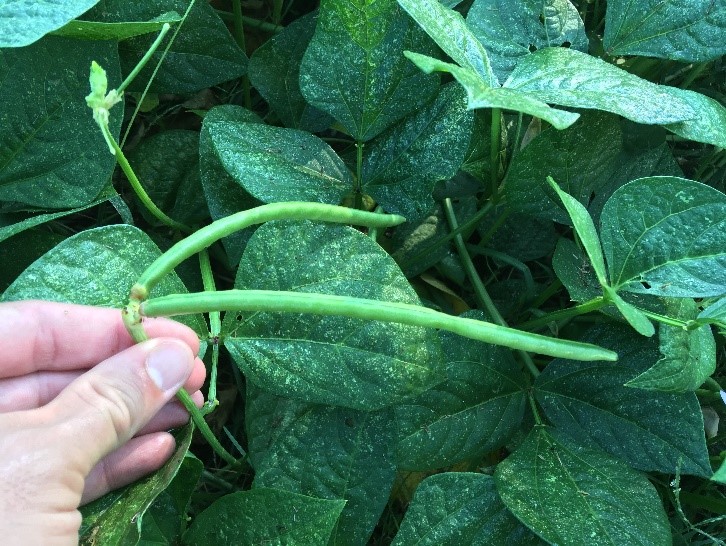
Top: Growth from a cowpea cover crop this summer. Note the weed suppression and biomass produced. Bottom Left: Here is an individual plant to see the growth and length of the stem. Bottom Right: Young pods starting to form on the plant. This is my signal that I need to terminate to prevent any re-seeding. Photos: N. Johanning
Less Seriously
https://www.chron.com/news/houston-texas/article/Texas-summer-heat-memes-12958688.php#photo-15646642
http://www.yourdestinationnow.com/2019/07/europe-is-dealing-with-its-extreme.html

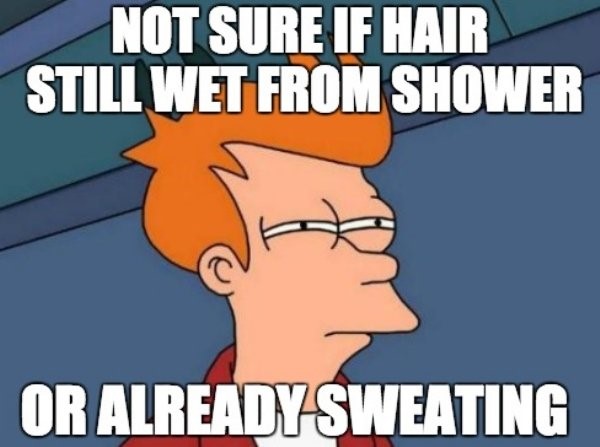
University of Illinois Extension Specialists in Fruit and Vegetable Production & Pest Management
Extension Educators – Local Food Systems and Small Farms |
||
Bronwyn Aly, Gallatin, Hamilton, Hardin, Pope, Saline, and White counties |
618-382-2662 |
|
Katie Bell, Franklin, Jackson, Perry, Randolph, & Williamson counties |
618-687-1727 |
|
Sarah Farley, Lake & McHenry counties |
847-223-8627 |
|
Nick Frillman, Woodford, Livingston, & McLean counties |
309-663-8306 |
|
Laurie George, Bond, Clinton, Jefferson, Marion, & Washington counties |
618-548-1446 |
|
Zachary Grant, Cook County | 708-679-6889 | |
Doug Gucker, DeWitt, Macon, and Piatt counties |
217-877-6042 |
|
Erin Harper, Champaign, Ford, Iroquois, and Vermillion counties |
217-333-7672 |
|
Grace Margherio, Jackie Joyner-Kersee Center, St. Clair County |
217-244-3547 |
|
Grant McCarty, Jo Daviess, Stephenson, and Winnebago counties |
815-235-4125 |
|
Katie Parker, Adams, Brown, Hancock, Pike and Schuyler counties |
217-223-8380 |
|
Kathryn Pereira, Cook County |
773-233-2900 |
|
James Theuri, Grundy, Kankakee, and Will counties |
815-933-8337 |
|
Extension Educators – Horticulture |
||
Chris Enroth, Henderson, Knox, McDonough, and Warren counties |
309-837-3939 |
|
Richard Hentschel, DuPage, Kane, and Kendall counties |
630-584-6166 |
|
Andrew Holsinger, Christian, Jersey, Macoupin, & Montgomery counties |
217-532-3941 |
|
Extension Educators - Commercial Agriculture |
||
Elizabeth Wahle, Fruit & Vegetable Production |
618-344-4230 |
|
Nathan Johanning, Madison, Monroe & St. Clair counties |
618-939-3434 |
|
Campus-based Extension Specialists |
||
Kacie Athey, Entomology |
217-244-9916 |
|
Mohammad Babadoost, Plant Pathology |
217-333-1523 |
|